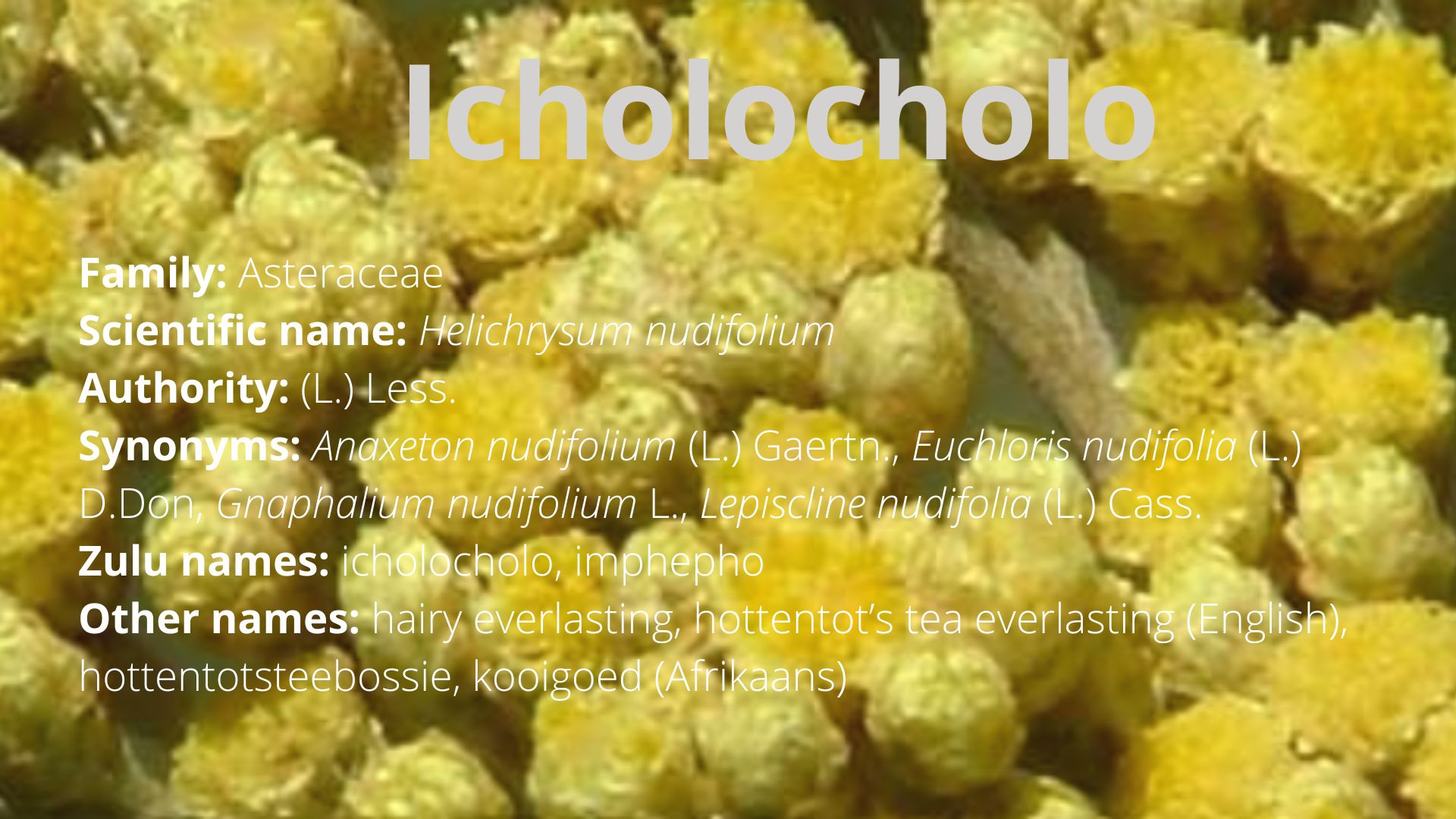Family: Asteraceae
Scientific name: Helichrysum nudifolium
Authority: (L.) Less.
Synonyms: Anaxeton nudifolium (L.) Gaertn., Euchloris nudifolia (L.) D.Don, Gnaphalium nudifolium L., Lepiscline nudifolia (L.) Cass.
Zulu names: icholocholo, imphepho
Other names: hairy everlasting, hottentot’s tea everlasting (English), hottentotsteebossie, kooigoed (Afrikaans)
Description: H.nudifolium is a perennial herb (or small shrub) that grows in grassland habitats near wet areas. It has long, narrowly ovate leaves that are hairless above and hairy beneath, pale to bright yellow flowers, and achene fruits.
Uses:
- The plant is burnt as incense.
- The plant is used to make herbal tea.
- The plant is used to make an infusion to treat chest complaints, colds, fever, flu, headaches, pain, and tuberculosis.
- The plant is mixed with Commelina africana and Salvia triangularis to treat infertility in women.
- The plant is used to treat menstrual pain, pregnancy complications, and postpartum problems.
- The plant is used to treat scarification bruises.
- The leaves are ground to powder and mixed with butter and eaten to protect children from illness.
- The leaves are used as a bathing agent and steam bath agent to treat fever and nightmares.
- The leaves are used to treat allergies and skin infection, such as burns, sores, and wounds.
- The leaves are used to make poultice to treat swellings.
- The leaves are used to make a decoction to treat colic and the root decoction is used to encourage weaning in babies.
- The leaves are used to treat catarrh and ear infections, such as otitis.
- The leaves are used to treat black leg (gangraena emphysematosa) in livestock.
- The roots are used to make a decoction to treat internal sores.
- The roots are used as a protective charm against thunder.
References and further reading:
- Arnold, T.H., Prentice, C.A., Hawker, L.C., Snyman, E.E., Tomalin, M., Crouch, N.R. and Pottas-Bircher, C., 2002. Medicinal and Magical Plants of Southern Africa: an Annotated Checklist. National Botanical Institute, Pretoria, pp. 32–34.
- Bhat, R.B., 2013. Plants of Xhosa people in the Transkei region of Eastern Cape (South Africa) with major pharmacological and therapeutic properties. J. Med. Plants Res, 7, pp.1474-1480.
- Gerstner, J., 1938. A Preliminary Checklist of Zulu Names of Plants with Short Notes. Bantu Studies 12, pp. 321–342.
- Lamorde, M., Tabuti, J.R., Obua, C., Kukunda-Byobona, C., Lanyero, H., Byakika-Kibwika, P., Bbosa, G.S., Lubega, A., Ogwal-Okeng, J., Ryan, M. and Waako, P.J., 2010. Medicinal plants used by traditional medicine practitioners for the treatment of HIV/AIDS and related conditions in Uganda. Journal of ethnopharmacology, 130(1), pp.43-53.
- Long, C., 2005. Swaziland’s flora: siSwati names and uses. Swaziland National Trust Commission: Mbambane, Swaziland.
- Lourens, A.C.U., Viljoen, A.M. and Van Heerden, F.R., 2008. South African Helichrysum species: a review of the traditional uses, biological activity and phytochemistry. Journal of Ethnopharmacology, 119(3), pp.630-652.
- Mabogo, D.E.N., 2012. The ethnobotany of the Vhavenda (Doctoral dissertation, University of Pretoria).
- Maroyi, A., 2019. Helichrysum nudifolium (L.) Less.: review of its medicinal uses, phytochemistry and biological activities. J Pharm Nutr Sci, 9, pp.189-94.
- McGaw, L.J., Lall, N., Meyer, J.J.M., and Eloff, J.N., 2008. The potential of South African plants against Mycobacterium infections. J. Ethnopharmacol. 119, pp. 482–500.
- Moteetee, A., Moffett, R.O. and Seleteng-Kose, L., 2019. A review of the ethnobotany of the Basotho of Lesotho and the Free State Province of South Africa (South Sotho). South African Journal of Botany, 122, pp.21-56.
- Reddy, D., 2007. The phytochemistry and antimicrobial activity of selected indigenous Helichrysum species (Doctoral dissertation, University of the Witwatersrand).
- Sewani-Rusike, C.R. and Mammen, M., 2014. Medicinal plants used as home remedies: A family survey by first year medical students. African Journal of Traditional, Complementary and Alternative Medicines, 11(5), pp.67-72.
- Van Wyk, B.E., Oudtshoorn, B.V. and Gericke, N., 1997. Medicinal Plants of South Africa. Briza.
- Watt, J.M., Breyer-Brandwijk, M.G., 1962. Medicinal and poisonous plants of southern and eastern Africa, second edition. Livingstone, London.

